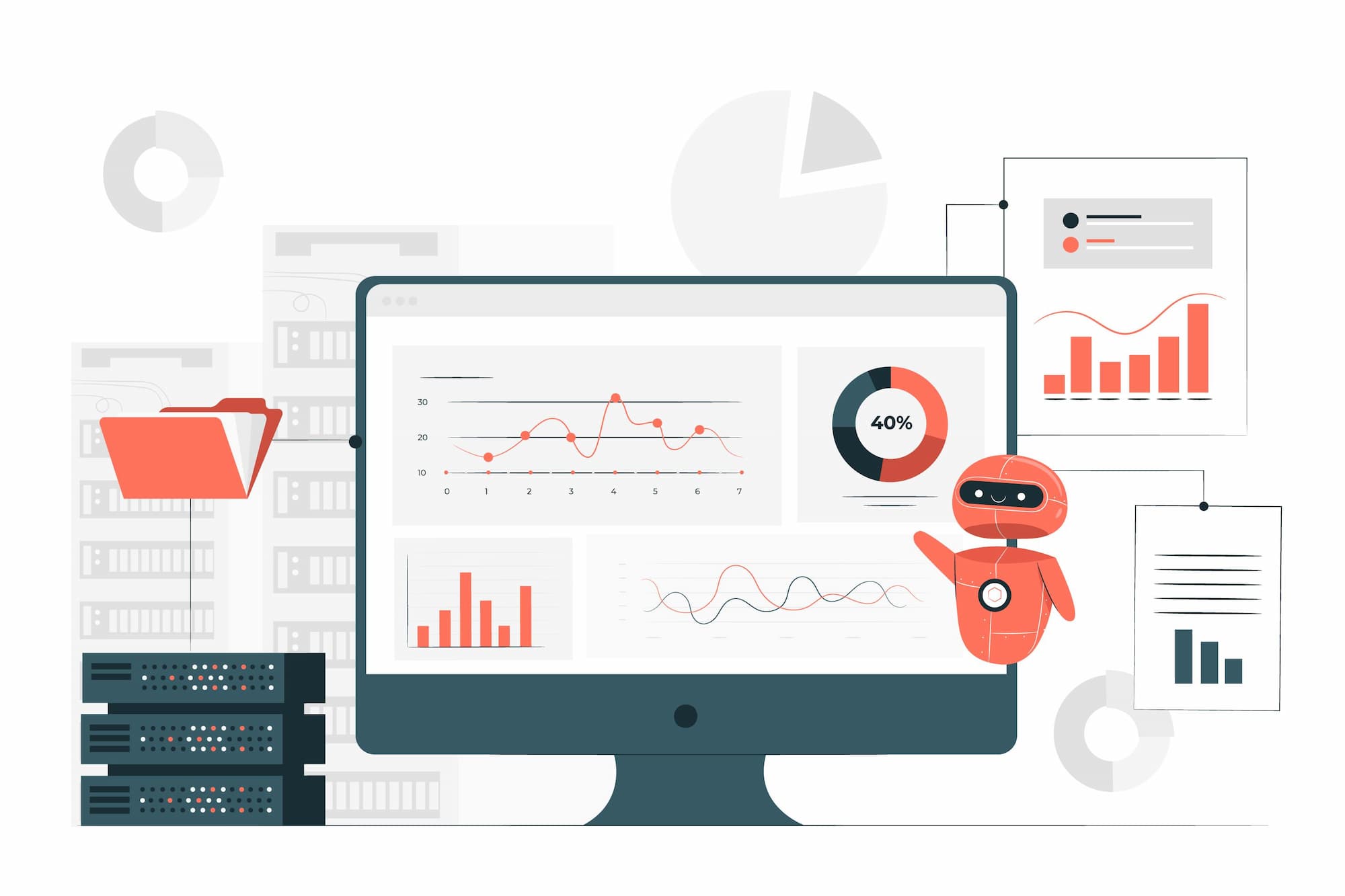Any time there’s data, there’s a chance to optimize results. There are hidden insights to discover. As a company that truly believes in the benefits of what data can bring and all the missing opportunities it could cause, we want to explain how it works, why it is important, and all the benefits in different industries.
Data Science Easily Explained
As the name states, data science is the study of data, aiming to extract meaningful insights that drive business decision-making. This multidisciplinary field draws on principles from mathematics, statistics, computer engineering, and artificial intelligence to analyze large amounts of data. Data science enables businesses to make sense of raw data and transform it into actionable knowledge. Organizations can stay ahead of the competition by identifying trends, predicting outcomes, and automating processes.
There are four types of data analytics at the heart of data science:
- Descriptive Analytics: Summarizes historical data to understand what happened. For instance, monitoring sales performance over time or tracking customer purchases per product line.
- Diagnostic Analytics: This type of analytics explores why certain events occurred, often by identifying trends or patterns in the data. A typical use case involves analyzing reduced sales figures, possibly identifying causes such as a decrease in average ticket size per client.
- Predictive Analytics: Leverages historical data to forecast future trends. Predicting customer churn using machine learning models is a common example, where algorithms identify at-risk customers based on past behavior.
- Prescriptive Analytics: Suggests actionable solutions. Businesses may use prescriptive analytics to optimize marketing campaigns or improve supply chain efficiency.
Thomas H. Davenport, a pioneer in business analytics, has significantly contributed to applying these analytics in organizations. His bestseller book Competing on Analytics highlights how companies gain competitive advantage through analytical approaches. Davenport’s work illustrates the importance of data-driven decision-making in achieving business success.
Why is Data Science Important? How is it Changing the Game?
In the age of information, data is an invaluable asset. Data science empowers companies to harness this asset by turning raw data into actionable insights. The impact is transformative across industries, reshaping how businesses operate, innovate, and compete.
- Data-Driven Decision Making: Data science gives businesses the tools to make more informed decisions. Instead of relying on intuition, decision-makers can analyze vast datasets to determine the best action.
- Increased Efficiency: Businesses can streamline operations and reduce human error through automation and machine learning models. For example, AI-powered chatbots can enhance customer service, and data science models can optimize supply chains, reducing costs and improving efficiency.
- Enhanced Customer Insights: Understanding customer behavior is crucial for developing better products and services. Data science can analyze customer interactions, helping businesses predict needs, personalize experiences, and increase customer satisfaction.
- Innovation: Data science fosters innovation by enabling businesses to quickly identify new opportunities, forecast trends, and pivot in response to market changes. In fields like computer vision and deep learning, innovations driven by data science are revolutionizing sectors like healthcare, retail, and autonomous driving.
By capitalizing on these insights, businesses that adopt data science gain a substantial competitive edge, positioning themselves as industry leaders.
Use Cases of Data Science in Different Industries
Data science is a versatile tool that delivers value across various sectors. Let’s look at some real-world applications:
- Retail: Predictive analytics helps retailers forecast demand, optimize inventory management, and design targeted marketing campaigns. Descriptive analytics might track sales per account or product line, while diagnostics can explain why certain products underperform. Check out our solution for ULTA Beauty.
- Healthcare: Data science is vital in predictive diagnostics and personalized medicine. AI models trained on medical data predict patient outcomes, helping clinicians make better treatment decisions. Prescriptive analytics enables better hospital resource allocation and scheduling.
- Manufacturing: In the manufacturing industry, predictive maintenance uses machine learning to anticipate equipment failure before it happens. This reduces downtime and improves efficiency. Data science also supports quality control through real-time analytics, ensuring products meet stringent standards.
- Finance: Financial institutions use data science to detect fraud, assess credit risk, and improve customer retention strategies. Machine learning models identify suspicious transactions, while predictive analytics help anticipate market trends and guide investment decisions. Check out our solution for Evertec.
- Entertainment: Companies like Netflix and Universal use data science to provide personalized recommendations and optimize content creation. These platforms engage customers with tailored content, analyzing user preferences and viewing history.
- Fitness & Wellness: Understanding your users data can provide personlized training, adjusting your recommendations according to the users preferences. Check ot our case study with Tonal.
These are only examples of what data science can do for these companies and industries.

The Lifecycle of Data
To ensure data is properly collected, analyzed, and applied, it takes several key phases that could entail:
- Data Collection: This initial step involves gathering data from multiple sources: customer databases, machine sensors, or external datasets. The goal is to collect clean, relevant, and structured data for analysis.
- Data Processing and Cleaning: Raw data often contains errors, missing values, or inconsistencies. Data cleaning ensures the data is complete, accurate, and ready for analysis.
- Data Exploration: In this phase, data scientists explore the data, identifying trends, correlations, and outliers. This helps determine which models or algorithms might be most suitable for analysis.
- Modeling: Once the data is prepared, machine learning algorithms are applied to uncover insights. For instance, supervised learning models are used for predictive analytics (e.g., churn detection), while unsupervised learning helps with tasks like customer segmentation.
- Evaluation: After building a model, it is essential to evaluate its performance. Data scientists test the model’s accuracy, precision, and recall to ensure that it meets business objectives.
- Deployment: A well-performing model is deployed to production, where it can inform real-time decisions. For example, a predictive maintenance model might be deployed in a factory to prevent equipment failure.
- Monitoring: Data science is an iterative process. Once a model is deployed, continuous monitoring is necessary to ensure it performs well over time, and updates may be required based on new data.
What Do You Need to Apply Data Science?
To successfully implement data science within an organization, there are some things we consider key to turn it into a success.
The first one would be skilled Talent. A strong data science team comprises statistics, machine learning, data engineering, and domain knowledge experts. It is essential to have experienced professionals who understand data science's technical and business aspects. This could save you a lot of time and money.
The second thing you need is infrastructure. Advanced tools and technologies are necessary to collect, store, and analyze large datasets. Cloud platforms like AWS and Google Cloud provide scalable infrastructure, while software tools like Python, R, and TensorFlow enable complex data processing and model development.
Then, you need data governance. It is crucial to ensure data is properly managed, secured, and compliant with regulations. Good data governance policies help maintain data integrity and privacy, which is particularly important when dealing with sensitive information.
Last but not least, collaboration. Data science projects often require cross-functional collaboration between data scientists, engineers, and business leaders. Clear communication and alignment on goals are key to success. Here we match it to the first point on this list. A good and experienced team is the foundation, so take your time there. Check out ourarticle on what is data engineering if you'd like to learn more.
Conclusion
Data science is revolutionizing industries by turning data into powerful insights. The applications are vast and varied, from manufacturing predictive maintenance to retail customer segmentation. As a business leader, having a clear path for handling data science isn’t just a competitive advantage; it’s becoming necessary.
At Digital Sense, our expertise in AI, machine learning, and data science enables us to help businesses get you to where you should be using the information you already know but didn’t notice before. With over 100 successful projects and a world-class team, we are dedicated to delivering innovative solutions tailored to your needs.
To learn more about how data science can drive your business forward, explore our data science services, case studies or contact us.




